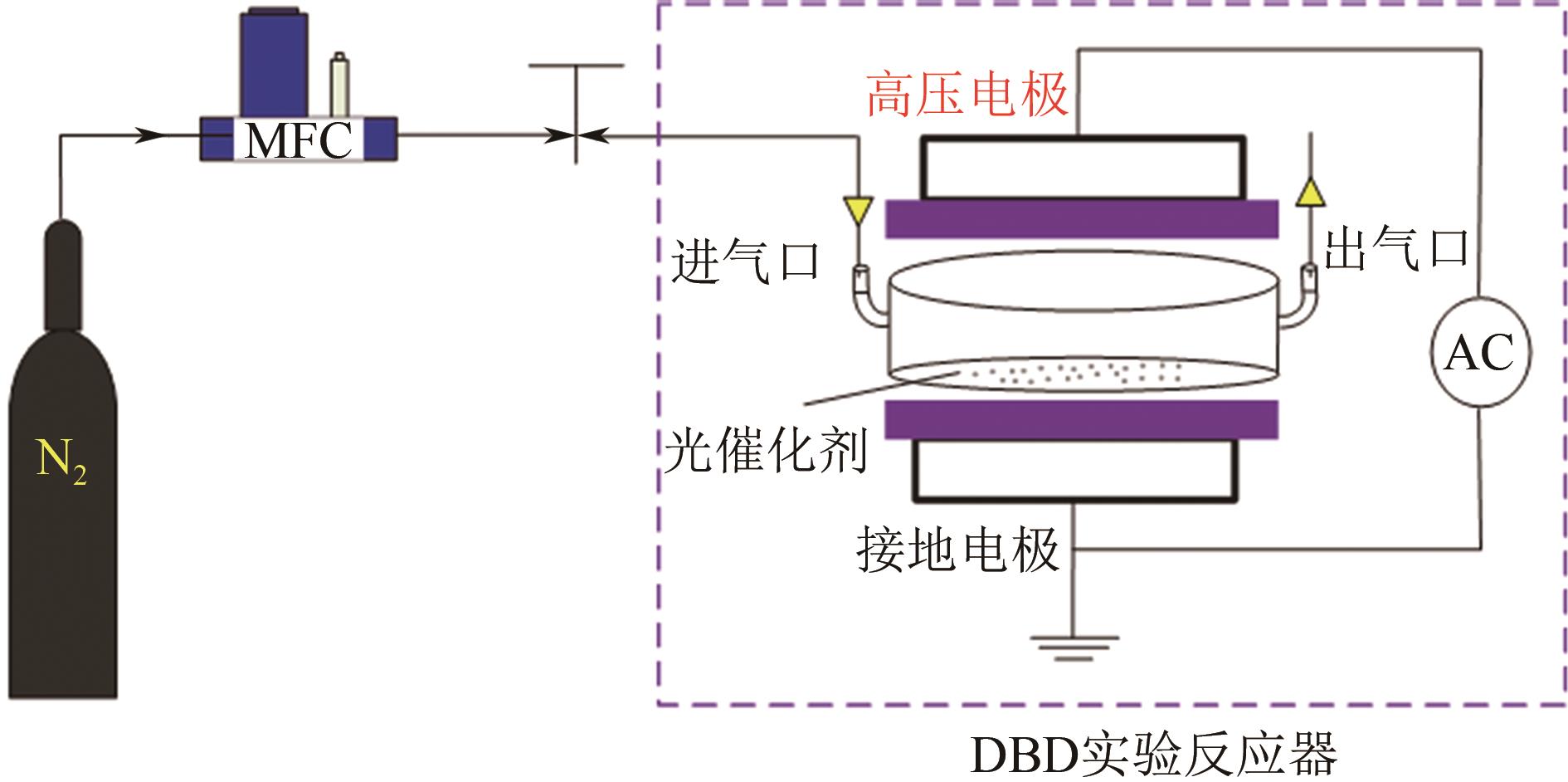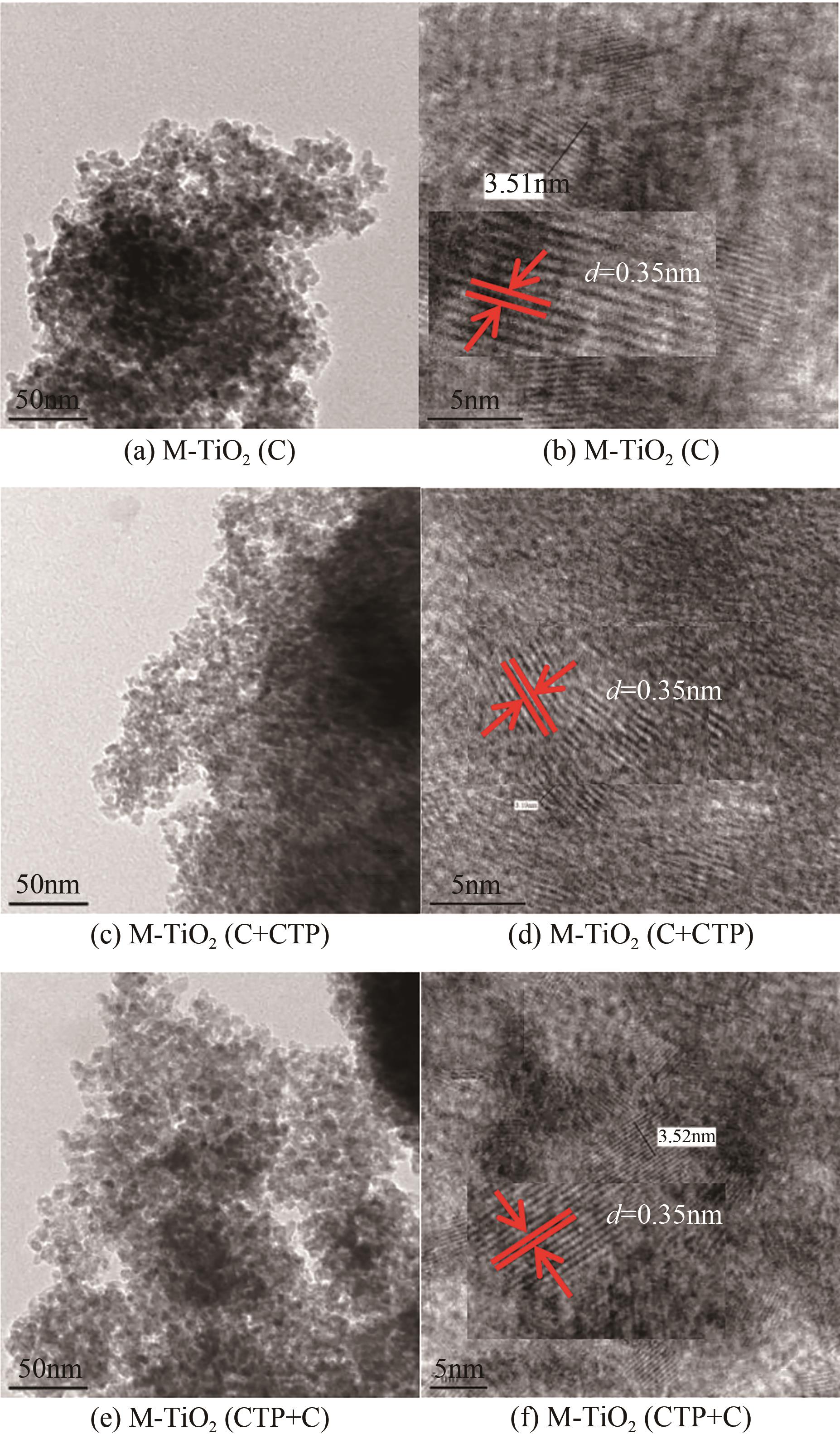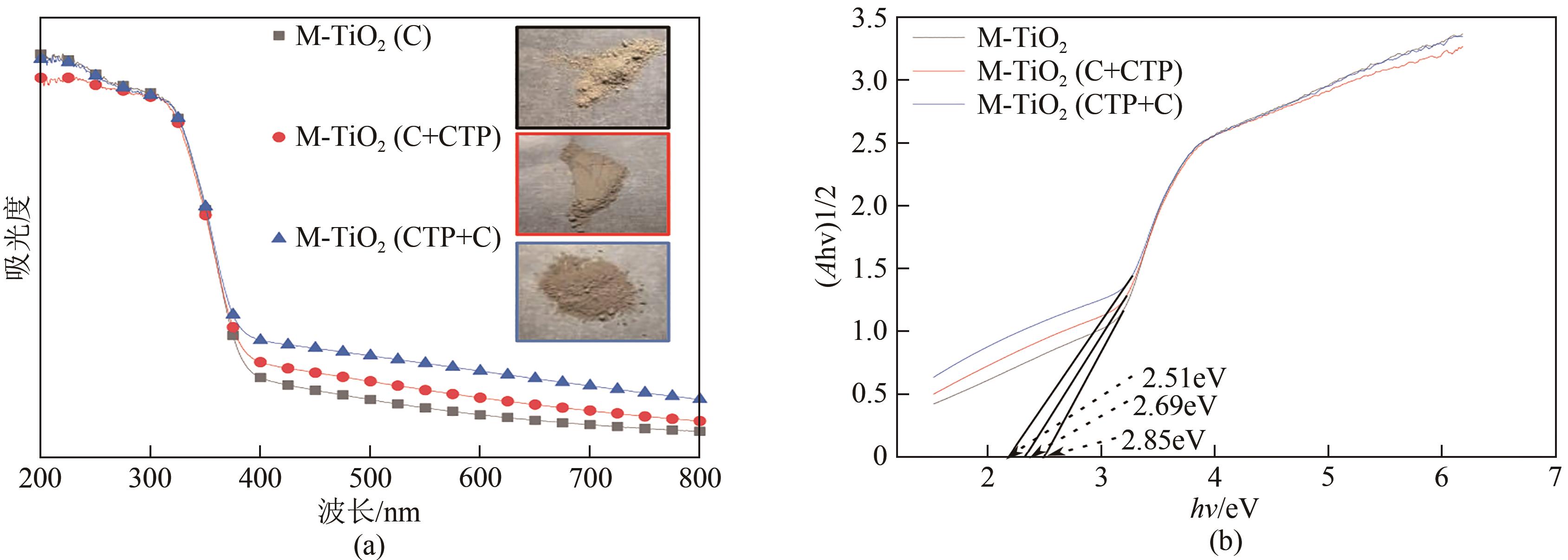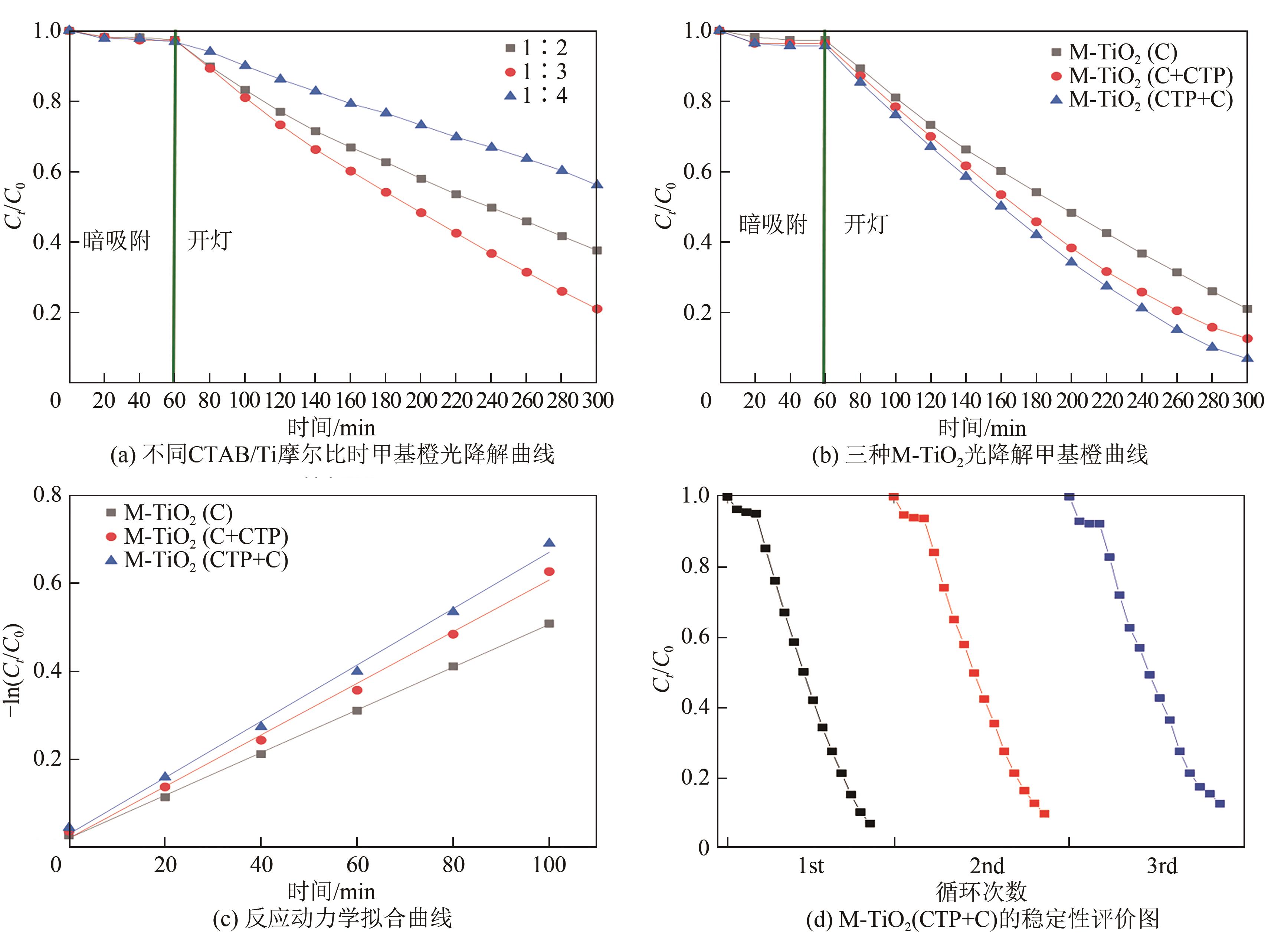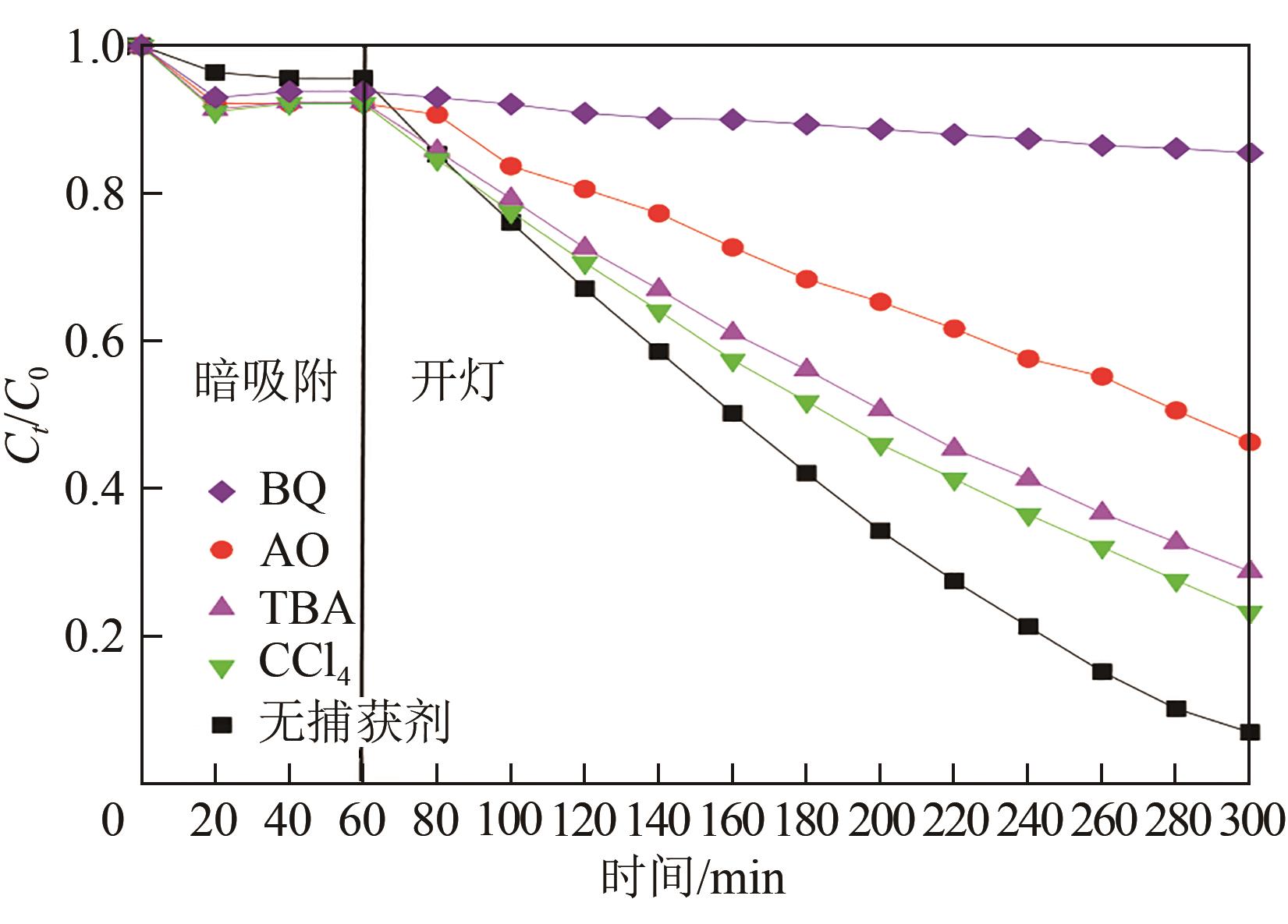化工进展 ›› 2022, Vol. 41 ›› Issue (11): 5820-5829.DOI: 10.16085/j.issn.1000-6613.2022-0126
N2等离子体改性介孔TiO2的可见光催化性能及机理
赵文霞1,2( ), 赵玉1,2, 柴子茹1,2, 张硕1,2, 王世欣1,2, 焦志杰1,2
), 赵玉1,2, 柴子茹1,2, 张硕1,2, 王世欣1,2, 焦志杰1,2
- 1.河北科技大学环境科学与工程学院,河北 石家庄 050018
2.河北科技大学河北省污染防治生物技术 重点实验室,河北 石家庄 050018
-
收稿日期:2022-01-20修回日期:2022-04-19出版日期:2022-11-25发布日期:2022-11-28 -
通讯作者:赵文霞 -
作者简介:赵文霞(1973—),女,博士,教授,研究方向为环境污染控制理论及技术。E-mail:kd2010zwx@163.com。 -
基金资助:国家重点研发计划重点专项(2016YFC0207907);河北省高等学校科学技术研究项目(QN2021065);河北省自然科学基金(E2022208038);河北省高等学校科学技术研究重点项目(ZD2020345)
Visible-light catalytic performance and mechanism of mesoporous TiO2 modified by N2 plasma
ZHAO Wenxia1,2( ), ZHAO Yu1,2, CHAI Ziru1,2, ZHANG Shuo1,2, WANG Shixin1,2, JIAO Zhijie1,2
), ZHAO Yu1,2, CHAI Ziru1,2, ZHANG Shuo1,2, WANG Shixin1,2, JIAO Zhijie1,2
- 1.College of Environmental Science and Engineering, Hebei University of Science and Technology, Shijiazhuang 050018, Hebei, China
2.Key Laboratory of Pollution Prevention and Control Biotechnology of Hebei Province, Hebei University of Science and Technology, Shijiazhuang 050018, Hebei, China
-
Received:2022-01-20Revised:2022-04-19Online:2022-11-25Published:2022-11-28 -
Contact:ZHAO Wenxia
摘要:
在石英平板介质阻挡放电(DBD)反应器中,采用氮气(N2)低温等离子体改性制备介孔TiO2光催化剂(M-TiO2)。借助XRD、TEM、BET、UV-vis DRS和XPS等手段对M-TiO2进行表征分析。结果表明,N2等离子体与煅烧相结合的处理方式下制得的M-TiO2较单纯煅烧处理方式具有更优的可见光催化性能。当CTAB/Ti摩尔比为1/3时,三种M-TiO2中M-TiO2(CTP+C)的比表面积最高(238.2m2/g),禁带宽度最窄(2.51eV),OV/O最大(35.7%);可见光持续照射240min时,M-TiO2(CTP+C)对甲基橙(MO)的光降解率最高,达90%以上,且循环稳定性良好。N2低温等离子体改性过程可有效改善M-TiO2晶粒的分散性,促进Ti4+向Ti3+的转化,其可见光催化活性的提高主要归因于氧空位、间隙碳和间隙氮三者的共同作用。活性物种捕获实验和莫特-肖特基曲线测试结果表明,可见光下降解甲基橙的过程中起主要作用的是O2▪-和h+。在此基础上,给出了M-TiO2(CTP+C)可见光催化的机理模型。
中图分类号:
引用本文
赵文霞, 赵玉, 柴子茹, 张硕, 王世欣, 焦志杰. N2等离子体改性介孔TiO2的可见光催化性能及机理[J]. 化工进展, 2022, 41(11): 5820-5829.
ZHAO Wenxia, ZHAO Yu, CHAI Ziru, ZHANG Shuo, WANG Shixin, JIAO Zhijie. Visible-light catalytic performance and mechanism of mesoporous TiO2 modified by N2 plasma[J]. Chemical Industry and Engineering Progress, 2022, 41(11): 5820-5829.
| 光催化剂 | BET比表面积/m2·g-1 | 孔容/cm3·g-1 | 平均孔径/nm |
|---|---|---|---|
| M-TiO2(C) | 226.7 | 0.356 | 4.8 |
| M-TiO2(C+CTP) | 233.8 | 0.346 | 5.0 |
| M-TiO2(CTP+C) | 238.2 | 0.392 | 5.7 |
表1 BET比表面积及孔结构参数
| 光催化剂 | BET比表面积/m2·g-1 | 孔容/cm3·g-1 | 平均孔径/nm |
|---|---|---|---|
| M-TiO2(C) | 226.7 | 0.356 | 4.8 |
| M-TiO2(C+CTP) | 233.8 | 0.346 | 5.0 |
| M-TiO2(CTP+C) | 238.2 | 0.392 | 5.7 |
| 样品 | 相对含量/% | 原子含量/% | |||||||
|---|---|---|---|---|---|---|---|---|---|
| Ti3+/Ti | OV/O | C—O—Ti/C | Ti—O—N/N | N2*/N | Ti | O | C | N | |
| M-TiO2(C) | 0 | 23.5 | 8.5 | 76.5 | 23.5 | 23.5 | 58.1 | 17.1 | 1.3 |
| M-TiO2(C+CTP) | 9.3 | 30.7 | 9.3 | 74.8 | 25.2 | 23.2 | 57.1 | 18.4 | 1.3 |
| M-TiO2(CTP+C) | 12.4 | 35.7 | 13.6 | 74.3 | 25.7 | 23.3 | 55.6 | 19.6 | 1.5 |
表2 XPS分析结果
| 样品 | 相对含量/% | 原子含量/% | |||||||
|---|---|---|---|---|---|---|---|---|---|
| Ti3+/Ti | OV/O | C—O—Ti/C | Ti—O—N/N | N2*/N | Ti | O | C | N | |
| M-TiO2(C) | 0 | 23.5 | 8.5 | 76.5 | 23.5 | 23.5 | 58.1 | 17.1 | 1.3 |
| M-TiO2(C+CTP) | 9.3 | 30.7 | 9.3 | 74.8 | 25.2 | 23.2 | 57.1 | 18.4 | 1.3 |
| M-TiO2(CTP+C) | 12.4 | 35.7 | 13.6 | 74.3 | 25.7 | 23.3 | 55.6 | 19.6 | 1.5 |
| 光催化剂 | R2 | kapp/min |
|---|---|---|
| M-TiO2(C) | 0.99364 | 0.00929 |
| M-TiO2(C+CTP) | 0.99762 | 0.01211 |
| M-TiO2(CTP+C) | 0.99632 | 0.01275 |
表3 可见光降解甲基橙的线性回归系数及表观速率常数
| 光催化剂 | R2 | kapp/min |
|---|---|---|
| M-TiO2(C) | 0.99364 | 0.00929 |
| M-TiO2(C+CTP) | 0.99762 | 0.01211 |
| M-TiO2(CTP+C) | 0.99632 | 0.01275 |
| 1 | 李宁, 张伟, 李贵贤, 等. TiO2光催化剂的研究进展[J]. 精细化工, 2021, 38(11): 2181-2188, 2258. |
| LI Ning, ZHANG Wei, LI Guixian, et al. Research progress of TiO2 photocatalysts[J]. Fine Chemicals, 2021, 38(11): 2181-2188, 2258. | |
| 2 | 刘静, 高正阳, 王杰, 等. 共掺杂改性TiO2光催化剂的研究进展[J]. 材料导报, 2021, 35(S1): 42-47. |
| LIU Jing, GAO Zhengyang, WANG Jie, et al. Research progress of co-doped TiO2 photocatalys[J]. Materials Reports, 2021, 35(S1): 42-47. | |
| 3 | SCHNEIDER Jenny, MATSUOKA Masaya, Masato Takeuchi, et al. Understanding TiO2 photocatalysis: mechanisms and materials[J]. Chemical Reviews, 2014, 114(19): 9919-9986. |
| 4 | 杜意恩, 牛宪军, 李万喜, 等. 高活性晶面锐钛矿型TiO2纳米材料的溶剂热法制备及其光催化性能[J]. 无机化学学报, 2021, 37(10): 1753-1763. |
| DU Yi’en, NIU Xianjun, LI Wanxi, et al. Solvothermal synthesis of high‑reactive faceted anatase TiO2 nanomaterials with improved photocatalytic performance[J]. Chinese Journal of Inorganic Chemistry, 2021, 37(10): 1753-1763. | |
| 5 | ATITAR Faycal M, ISMAIL Adel A, AL-SAYARI S A, et al. Mesoporous TiO2 nanocrystals as efficient photocatalysts: impact of calcination temperature and phase transformation on photocatalytic performance[J]. Chemical Engineering Journal, 2015, 264: 417-424. |
| 6 | LI Xiao, LIU Pengwei, MAO Yu, et al. Preparation of homogeneous nitrogen-doped mesoporous TiO2 spheres with enhanced visible-light photocatalysis[J]. Applied Catalysis B: Environmental, 2015, 164: 352-359. |
| 7 | LIU Di, YONG Guangbi, Controllable fabrication of hollow TiO 2 spheres as sustained release drug carrier[J]. Advanced Powder Technology, 2019, 30(10): 2169-2177. |
| 8 | 张艳青, 纪庆鹏, 黄悦, 等. 模板法制备介孔TiO2及其在模拟太阳光下光催化还原Cr(Ⅵ)性能的研究[J]. 化工新型材料, 2022, 50(2): 176-180, 186. |
| ZHANG Yanqing, JI Qingpeng, HUANG Yue, et al. Preparation of mesoporous TiO2 by template method and its photocatalytic reduction Cr(Ⅵ) properties under simulated sunlight[J]. New Chemical Materials, 2022, 50(2): 176-180, 186. | |
| 9 | LIU Chen, LI Youji, XU Peng, et al. Preparation and improved photocatalytic activity of ordered mesoporous TiO2 by evaporation induced self-assembly technique using liquid crystal as template[J]. Transactions of Nonferrous Metals Society of China, 2014, 24(4): 1072-1078. |
| 10 | SHI Yifeng, WAN Ying, ZHAO Dongyuan. Ordered mesoporous non-oxide materials[J]. Chemical Society Reviews, 2011, 40(7): 3854-3878. |
| 11 | ERLANDY Toe dwinanto, KURNIAWAN Winarto, MARIQUIT Eden G, et al. Synthesis of N-doped mesoporous TiO2 by facile one-step solvothermal process for visible light photocatalytic degradation of organic pollutant[J]. Journal of Environmental Chemical Engineering, 2018, 6(4): 5125-5134. |
| 12 | LI Yulin, HAN Xiaojin, HOU Yaqin, et al. In situ preparation of mesoporous Fe/TiO2 catalyst using Pluronic F127-assisted sol-gel process for mid-temperature NH3 selective catalytic reduction[J]. Chinese Journal of Catalysis, 2017, 38(11): 1831-1841. |
| 13 | CAO Zhenhao, LI Wenting, PANG Juanjuan, et al. Mesoporous TiO2 with tunable mixed phase (anatase/rutile) and morphology by using polyethyleneimine modified F127 block copolymers as templates for enhanced photocatalytic performance[J]. Science of Advanced Materials, 2019, 11(2): 166-177. |
| 14 | PASINI Sarah mozzaquatro, Alexsandra VALÉRIO, GUELLI ULSON DE SOUZA Selene M A, et al. Plasma-modified TiO2 polyetherimide nanocomposite fibers for photocatalytic degradation of organic compounds[J]. Journal of Environmental Chemical Engineering, 2019, 7(4): 103213. |
| 15 | LIU Xinghui, HUA Ruinian, NIU Jinhai, et al. N2 plasma treatment TiO2 nanosheets for enhanced visible light-driven photocatalysis[J]. Journal of Alloys and Compounds, 2021, 881: 160509. |
| 16 | 陈梦晗, 竺新波, 蔡宇翔, 等. 低温等离子体改性Mn-CeO x 催化剂强化甲硫醚催化氧化性能的机理[J]. 高电压技术, 2019, 45(2): 630-636. |
| CHEN Menghan, ZHU Xinbo, CAI Yuxiang, et al. Mechanism of catalytic oxidation enhancement of dimethyl dulfides over the Mn-CeO x catalyst modified by nonthermal plasma[J]. High Voltage Engineering, 2019, 45(2): 630-636. | |
| 17 | ISLAM Syed Z, REED Allen, KIM Doo young, et al. N2/Ar plasma induced doping of ordered mesoporous TiO2 thin films for visible light active photocatalysis[J]. Microporous and Mesoporous Materials, 2016, 220: 120-128. |
| 18 | HU Biao, LIANG Chuanhui, YANG Feng, et al. TiO2 powder modified by plasma afterglow: a correlation between active species, microstructure, and optical properties[J]. Materials Letters, 2020, 268: 127577. |
| 19 | 李政楷, 陈雷, 王美琪, 等. 大气压氩气/空气针-环式介质阻挡放电发射光谱诊断[J]. 光谱学与光谱分析, 2021, 41(10): 3307-3310. |
| LI Zhengkai, CHEN Lei, WANG Meiqi, et al. Diagnosis of atmospheric pressure argon/air needle-ring dielectric barrier discharge emission spectrum[J]. Spectroscopy and Spectral Analysis, 2021, 41(10): 3307-3310. | |
| 20 | JIN Xianghui, TANG Tao, TAO Xumei, et al. A novel dual-ligand Fe-based MOFs synthesized with dielectric barrier discharge (DBD) plasma as efficient photocatalysts[J]. Journal of Molecular Liquids, 2021, 340: 117290. |
| 21 | ZHAO Wenxia, LIU Shuai, ZHANG Shuo, et al. Preparation and visible-light photocatalytic activity of N-doped TiO2 by plasma-assisted sol-gel method[J]. Catalysis Today, 2019, 337: 37-43. |
| 22 | 赵文霞, 王蕊, 张硕, 等. 氮气低温等离子体辅助制备N-TiO2及其光催化活性[J]. 精细化工, 2020, 37(4): 752-757, 764. |
| ZHAO Wenxia, WANG Rui, ZHANG Shuo, et al. Preparation of N-TiO2 assisted by low-temperature N2 plasma and its photocatalytic activity[J]. Fine Chemicals, 2020, 37(4): 752-757, 764. | |
| 23 | YUAN Zhongyong, REN Tiezhen, VANTOMME Aurélien, et al. Facile and generalized preparation of hierarchically mesoporous-macroporous binary metal oxide materials[J]. Chemistry of Materials, 2004, 16(24):5096-5106. |
| 24 | 龙彩燕, 刘成超, 赵燕熹, 等. 高比表面积介孔TiO2的制备及负载钴基催化剂费-托合成反应性能研究[J]. 分子科学学报, 2020, 36(03): 205-211. |
| LONG Caiyan, LIU Chengchao, ZHAO Yanxi, et al. Preparation of mesoporous TiO2 with high surface area and study on the performance of Fischer-Tropsch synthesis of supported cobalt catalyst[J]. Journal of Molecular Science, 2020, 36(03): 205-211. | |
| 25 | 李翠霞, 孙会珍, 金海泽, 等. 3D多级孔rGO/TiO2复合材料的构筑及其光催化性能研究[J]. 无机材料学报, 2021, 36(10): 1039-1046. |
| LI Cuixia, SUN Huizhen, JIN Haize, et al. Construction and photocatalytic performance of 3D hierarchical pore rGO/TiO2 composites[J]. Journal of Inorganic Materials, 2021, 36(10): 1039-1046. | |
| 26 | ZHANG Xiaotong, ZHOU Guowei, XU Jing, et al. Synthesis and photocatalytic activity of co-doped mesoporous TiO2 on Brij98/CTAB composite surfactant template[J]. Journal of Solid State Chemistry, 2010, 183(6): 1394-1399. |
| 27 | KHOJASTEH Farzaneh, MERSAGH Mansour rezaee, HASHEMIPOUR Hassan. The influences of Ni, Ag-doped TiO2 and SnO2, Ag-doped SnO2/TiO2 nanocomposites on recombination reduction in dye synthesized solar cells[J]. Journal of Alloys and Compounds, 2022, 890: 161709. |
| 28 | YIN Jinpeng, GAO Wenyuan, YAN Shuang, et al. Facile synthesis of CTAB-SM-TiO2 nanophotocatalyst and its superior photocatalytic performance[J]. Materials Science in Semiconductor Processing, 2018, 74: 284-291. |
| 29 | 徐凌, 唐超群, 钱俊. C掺杂锐钛矿相TiO2吸收光谱的第一性原理研究[J]. 物理学报, 2010, 59(04): 2721-2727. |
| XU Ling, TANG Chaoqun, QIAN Jun. The first-principles study of absorption spectrum of C-doped anatase TiO2 [J]. Acta Physica Sinica, 2010, 59(04): 2721-2727. | |
| 30 | LI Wei, WU Zhangxiong, WANG Jinxiu, et al. A perspective on mesoporous TiO2 materials[J]. Chemistry of Materials, 2014, 26(1): 287-298. |
| 31 | ZHANG Bo, PENG Xiangfeng, WANG Zhao. Noble metal-free TiO2-coated carbon nitride layers for enhanced visible light-driven photocatalysis[J]. Nanomaterials, 2020, 10(4): 805. |
| 32 | KALANTARI Kaveh, KALBASI Mansour, SOHRABI Morteza, et al. Synthesis and characterization of N-doped TiO2 nanoparticles and their application in photocatalytic oxidation of dibenzothiophene under visible light[J]. Ceramics International, 2016, 42(13):14834-14842. |
| 33 | CHOI Wonyong, TERMIN Andreas, HOFFMANN Michael R. The role of metal ion dopants in quantum-sized TiO2: correlation between photoreactivity and charge carrier recombination dynamics[J]. The Journal of Physical Chemistry, 1994, 98(51): 13669-13679. |
| 34 | XU Xing, LAI Lei, ZENG Tao, et al. In situ formation of pyridine-type carbonitrides-modified disorder-engineered C-TiO2 used for enhanced visible-light-driven photocatalytic hydrogen evolution[J]. The Journal of Physical Chemistry C. Nanomaterials and Interfaces, 2018, 122: 18870-18879. |
| 35 | PANDI Kavitha, PREEYANGHAA Mani, VINESH Vasudevan, et al.Complete photocatalytic degradation of tetracycline by carbon doped TiO2 supported with stable metal nitrate hydroxide[J]. Environmental Research, 2021, 207: 112188. |
| 36 | LIU Shixin, LIU Jinglin, LI Xiaosong, et al. Gliding arc plasma synthesis of visible-light active C-doped titania photocatalysts[J]. Plasma Processes and Polymers, 2014, 12(5): 422-430. |
| 37 | XU Chengkun, KILLMEYER Richard, GRAY Mcmahan L, et al. Photocatalytic effect of carbon-modified n-TiO2 nanoparticles under visible light illumination[J]. Applied Catalysis B: Environmental, 2006, 64(3/4): 312-317. |
| 38 | SU Xiaohui, HE Qingqing, YANG Yuane, et al. Free-standing nitrogen-doped TiO2 nanorod arrays with enhanced capacitive capability for supercapacitors[J]. Diamond and Related Materials, 2021, 114: 108168. |
| 39 | KOLI Valmiki B, MAVENGERE Shielah, KIM Jung-sik. An efficient one-pot N doped TiO2-SiO2 synthesis and its application for photocatalytic concrete[J]. Applied Surface Science, 2019, 491: 60-66. |
| 40 | ASAHI R, MORIKAWA T, OHWAKI T, et al. Visible-light photocatalysis in nitrogen-doped titanium oxides[J]. Science, 2001, 293(5528): 269-271. |
| 41 | IRIE Hiroshi, WATANABE Yuka, HASHIMOTO Kazuhito. Nitrogen-concentration dependence on photocatalytic activity of TiO2- x N x powders[J]. Journal of Physical Chemistry B, 2003, 107(23): 5483-5486. |
| 42 | ZHAO Yuxuan, NIE Lingzhi, YANG Hongli, et al. Tailored fabrication of TiO2/In2O3 hybrid mesoporous nanofibers towards enhanced photocatalytic performance[J]. Colloids and Surfaces A: Physicochemical and Engineering Aspects, 2021, 629: 127455. |
| 43 | SAHA Subhadeep, Gobinda DAS, THOTE Jayshri, et al. Photocatalytic metal-organic framework from CdS quantum dot incubated luminescent metallohydrogel[J]. Journal of the American Chemical Society, 2014, 136(42): 14845-14851. |
| 44 | HU Qingsong, CHEN Yong, LI Ming, et al. Construction of NH2-UiO-66/BiOBr composites with boosted photocatalytic activity for the removal of contaminants[J]. Colloids and Surfaces A: Physicochemical and Engineering Aspects, 2019, 579: 123625. |
| 45 | CHEN Xiangyan, PENG Xin, JIANG Longbo, et al. Photocatalytic removal of antibiotics by MOF-derived Ti3+- and oxygen vacancy-doped anatase/rutile TiO2 distributed in a carbon matrix[J]. Chemical Engineering Journal, 2022, 427: 130945. |
| 46 | XING Mingyang, FANG Wenzhang, NASIR Muhammad, et al. Self-doped Ti3+-enhanced TiO2 nanoparticles with a high-performance photocatalysis[J]. Journal of Catalysis, 2013, 297(1): 236-243. |
| 47 | YAO Yunjin, QIN Jiacheng, CHEN Hao, et al. One-pot approach for synthesis of N-doped TiO2/ZnFe2O4 hybrid as an efficient photocatalyst for degradation of aqueous organic pollutants[J]. Journal of Hazardous Materials, 2015, 291: 28-37. |
| [1] | 徐晨阳, 都健, 张磊. 基于图神经网络的化学反应优劣评价[J]. 化工进展, 2023, 42(S1): 205-212. |
| [2] | 张明焱, 刘燕, 张雪婷, 刘亚科, 李从举, 张秀玲. 非贵金属双功能催化剂在锌空气电池研究进展[J]. 化工进展, 2023, 42(S1): 276-286. |
| [3] | 时永兴, 林刚, 孙晓航, 蒋韦庚, 乔大伟, 颜彬航. 二氧化碳加氢制甲醇过程中铜基催化剂活性位点研究进展[J]. 化工进展, 2023, 42(S1): 287-298. |
| [4] | 谢璐垚, 陈崧哲, 王来军, 张平. 用于SO2去极化电解制氢的铂基催化剂[J]. 化工进展, 2023, 42(S1): 299-309. |
| [5] | 杨霞珍, 彭伊凡, 刘化章, 霍超. 熔铁催化剂活性相的调控及其费托反应性能[J]. 化工进展, 2023, 42(S1): 310-318. |
| [6] | 郑谦, 官修帅, 靳山彪, 张长明, 张小超. 铈锆固溶体Ce0.25Zr0.75O2光热协同催化CO2与甲醇合成DMC[J]. 化工进展, 2023, 42(S1): 319-327. |
| [7] | 王正坤, 黎四芳. 双子表面活性剂癸炔二醇的绿色合成[J]. 化工进展, 2023, 42(S1): 400-410. |
| [8] | 高雨飞, 鲁金凤. 非均相催化臭氧氧化作用机理研究进展[J]. 化工进展, 2023, 42(S1): 430-438. |
| [9] | 王乐乐, 杨万荣, 姚燕, 刘涛, 何川, 刘逍, 苏胜, 孔凡海, 朱仓海, 向军. SCR脱硝催化剂掺废特性及性能影响[J]. 化工进展, 2023, 42(S1): 489-497. |
| [10] | 赵景超, 谭明. 表面活性剂对电渗析减量化工业含盐废水的影响[J]. 化工进展, 2023, 42(S1): 529-535. |
| [11] | 邓丽萍, 时好雨, 刘霄龙, 陈瑶姬, 严晶颖. 非贵金属改性钒钛基催化剂NH3-SCR脱硝协同控制VOCs[J]. 化工进展, 2023, 42(S1): 542-548. |
| [12] | 许友好, 王维, 鲁波娜, 徐惠, 何鸣元. 中国炼油创新技术MIP的开发策略及启示[J]. 化工进展, 2023, 42(9): 4465-4470. |
| [13] | 陈林, 徐培渊, 张晓慧, 陈杰, 徐振军, 陈嘉祥, 密晓光, 冯永昌, 梅德清. 液化天然气绕管式换热器壳侧混合工质流动及传热特性[J]. 化工进展, 2023, 42(9): 4496-4503. |
| [14] | 耿源泽, 周俊虎, 张天佑, 朱晓宇, 杨卫娟. 部分填充床燃烧器中庚烷均相/异相耦合燃烧[J]. 化工进展, 2023, 42(9): 4514-4521. |
| [15] | 张帆, 陶少辉, 陈玉石, 项曙光. 基于改进恒热传输模型的精馏模拟初始化[J]. 化工进展, 2023, 42(9): 4550-4558. |
| 阅读次数 | ||||||
|
全文 |
|
|||||
|
摘要 |
|
|||||
